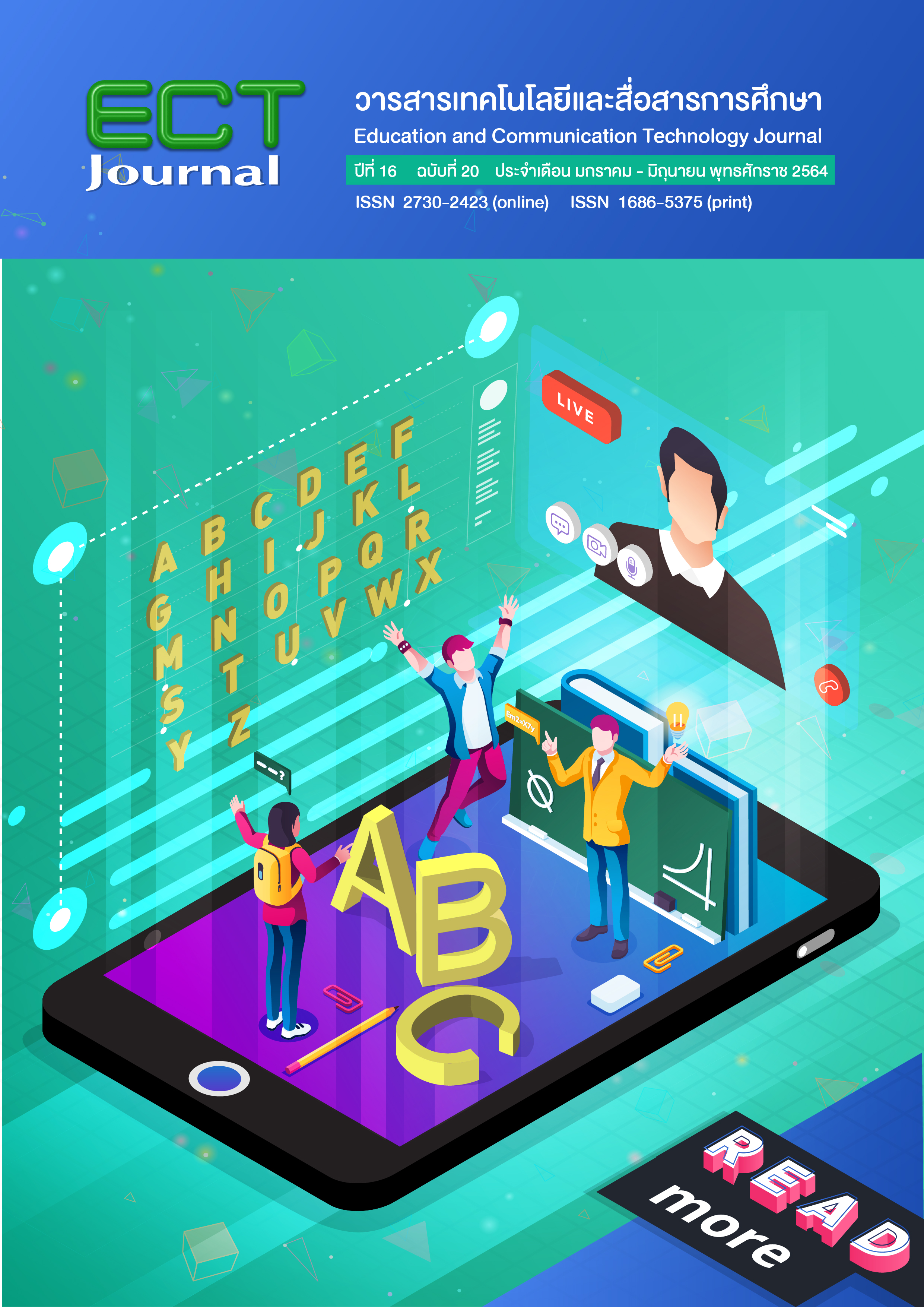A Survey of Online Learning Problems in General Education Course of University of Phayao Students
Keywords:
Problems of Online learning, General Education CourseAbstract
The purposes of this research were (1) to survey the students of the University of Phayao for their opinions on online learning in the general education course and (2) to survey problems of online learning in the general education course that the University of Phayao students encounter. The sample group consisted of 450 students from University of Phayao of which were divided into 3 groups of disciplines: Health Science, Science and Technology and Humanities and Social Science. The simple sample method was used in this research. The data was collected through questionnaires and analyzed by the mean values of standard deviation, frequency, percentage and content analysis.
The results of the research found that.
1) Health Science and Science and Technology students believed that the most important element that supports online learning are the students themselves. While Humanities and Social Science students think that interaction is the most important aspect to support online learning.
2) All three disciplines agree that the most problematic element in online learning are media technology and the internet network followed by the learners themselves and the teaching activities
References
กิตติชัย สุธาสิโนบล. (2562). หลักสูตรและการเรียนรู้แบบดิจิทัล. วารสารวิชาการศึกษาศาสตร์, 20(1), 200-211. https://so04.tci-thaijo.org/index.php/EDUCU/article/view/159288
ฐานเศรษฐกิจ. (2563, 18 พฤษภาคม). ยกปัญหา 8 ข้อ "เรียนออนไลน์" วันแรกวุ่น. ฐานเศรษฐกิจ. https://www.thansettakij.com/content/politics/434933
ถนอมพร เลาหจรัสแสง. (2545). รายงานการวิจัย เรื่อง ผลของการใช้การเรียนทางอิเล็กทรอนิกส์ (e-Learning) กระบวนวิชาภาษาอังกฤษขั้นพื้นฐานที่มีต่อผลสัมฤทธิ์ทางการเรียนและความคิดเห็นของนักศึกษาในระดับอุดมศึกษา. สำนักบริการคอมพิวเตอร์ มหาวิทยาลัยเชียงใหม่. https://cmu.to/prnThanomporn
นรินธน์ นนทมาลย์. (2560). การพัฒนารูปแบบการออกแบบการสอนแบบเปิดด้วยวิธีการคิดอย่างเป็นระบบและกระบวนการกลุ่มโดยใช้วิดีโอเป็นฐาน เพื่อพัฒนาความสามารถในการแก้ปัญหาเชิงสร้างสรรค์ของผู้เรียนระดับอุดมศึกษา [วิทยานิพนธ์ปริญญาดุษฎีบัณฑิต, จุฬาลงกรณ์มหาวิทยาลัย]. จุฬาลงกรณ์มหาวิทยาลัย คลังปัญญา. https://cuir.car.chula.ac.th/handle/123456789/59639
นรินธน์ นนทมาลย์ และนริศรา เสือคล้าย. (2563). รายงานการวิจัย เรื่อง ปัจจัยการกำกับตนเองที่ส่งผลต่อการจัดการเรียนการสอนออนไลน์ในรายวิชาการศึกษาทั่วไปของนิสิตมหาวิทยาลัยพะเยา. ทุนอุดหนุนการวิจัยจากโครงการสร้างบัณฑิตพันธุ์ใหม่ "ศึกษาทั่วไปสู่คนไทยที่มีคุณภาพ" มหาวิทยาลัยพะเยา. https://www.up.ac.th/th/research
ประสาท สืบค้า. (2563). นโยบายและแนวปฏิบัติสำหรับการเรียนการสอนออนไลน์ของมหาวิทยาลัยสุโขทัยธรรมาธิราชตามมาตรการการรักษาระยะห่างทางสังคม. วารสารเทคโนโลยีและสื่อสารการศึกษา, 15(18), A1-A10. https://so01.tci-thaijo.org/index.php/EDMKU/article/view/246159
ปัณฑิตา อินทรักษา. (2562). การจัดการเรียนรู้ด้วยสื่อสังคมออนไลน์. วารสารศึกษาศาสตร์ มหาวิทยาลัยนเรศวร, 21(4), 357-365. https://so03.tci-thaijo.org/index.php/edujournal_nu/article/view/157629
พิริยะ ผลพิรุฬห์. (2563, 5 พฤษภาคม). เรียน"ออนไลน์"กับการปิด-เปิดโรงเรียนในช่วงโควิด-19.Post Today. https://www.posttoday.com/finance-stock/columnist/621935
เอื้อมพร หลินเจริญ. (2555). เทคนิคการวิเคราะห์ข้อมูลเชิงคุณภาพ. วารสารการวัดผลการศึกษา, 17(1), 17-29. https://so06.tci-thaijo.org/index.php/NUEJ/article/view/7215
Ally, M. (2004). Foundations of educational theory for online learning. In T. Anderson & F. Elloumi (Eds.), Theory and practice of online learning. Athabasca University Press.
Anderson, T. (2004). Towards a theory of online learning. In T. Anderson & F. Elloumi (Eds.), Theory and practice of online learning. Athabasca University Press.
Anderson, T. (2008). The theory and practice of online learning (2nd ed.). Athabasca University Press.
Belarmino, J. A., & Bahle, A. (2019). A preliminary historical report on embracing online education in occupational therapy. The Open Journal of Occupational Therapy, 7(3), 1-10. https://doi.org/10.15453/2168-6408.1554
Boom Praniti. (2563, 27 เมษายน). เมื่อความไม่พร้อมด้านอุปกรณ์ กำลังจะทำให้ "การจัดการเรียนการสอนออนไลน์" ล้มเหลว. Billion Mindset. https://www.billionmindset.com/online-learning-obstacle/
Bourne, J., Harris, D., & Mayadas, F. (2005). Online engineering education: Learning anywhere, anytime. Journal of Engineering Education, 94(1), 131-146. https://doi.org/10.1002/j.2168-9830.2005.tb00834.x
Centre for Teaching Excellence. (2020). Developing online learning activities for blended courses. University of Waterloo. https://uwaterloo.ca/centre-for-teaching-excellence/teaching-resources/teaching-tips/developing-assignments/blended-learning/developing-online-learning-activities
DeNeui, D. L., & Dodge, T. L. (2006). Asynchronous learning networks and student outcomes: The utility of online learning components in hybrid courses. Journal of Instructional Psychology, 33(4), 256-259. https://www.researchgate.net/publication/261633784_Asynchronous_learning_networks_and_student_outcomes_The_utility_of_online_learning_components_in_hybrid_courses
Du, X., Yang, J., Shelton, B., & Hung, J.-L. (2019). Is learning anytime, anywhere a good strategy for success? Identifying successful spatial-temporal patterns of on-the-job and full-time students. Information Discovery and Delivery, 47(4), 173-181. https://doi.org/10.1108/IDD-09-2018-0047
Haythornthwaite, C., & Andrews, R. (2011). E-learning theory and practice. SAGE Publications. https://uk.sagepub.com/en-gb/eur/e-learning-theory-and-practice/book235534
Singh, V., & Thurman, A. (2019). How many ways can we define online learning? A systematic literature review of definitions of online learning (1988-2018). American Journal of Distance Education, 33(4), 289-306. https://doi.org/10.1080/08923647.2019.1663082
The Praxis Team. (2020). The beginner's guide: Online learning & self-directed education. Discover Praxis. https://discoverpraxis.com/online-learning-beginners-guide/
The Pro Vice-Chancellor. (2020). Online learning activities. UNSW Sydney. https://teaching.unsw.edu.au/online-learning-activities
Trifan, A., Stanciu, C., Stoica, O., Girleanu, I., & Cojocariu, C. (2014). Impact of Clostridium difficile infection on inflammatory bowel disease outcome: a review. World Journal of Gastroenterology, 20(33), 11736-11742. https://doi.org/10.3748/wjg.v20.i33.11736
Vai, M., & Sosulski, K. (2015). Essentials of online course design: A standards-based guide (2nd ed.). Routledge. https://www.routledge.com/Essentials-of-Online-Course-Design-A-Standards-Based-Guide/Vai-Sosulski/p/book/9781138780163
Watts, L. (2016). Synchronous and asynchronous communication in distance learning: A review of the literature. Quarterly Review of Distance Education, 17(1), 23-32. https://www.infoagepub.com/qrde-issue.html?i=p57c7ddca01643
Downloads
Published
How to Cite
Issue
Section
License
Copyright (c) 2021 มหาวิทยาลัยสุโขทัยธรรมาธิราช

This work is licensed under a Creative Commons Attribution-NonCommercial-NoDerivatives 4.0 International License.
1. ทรรศนะและข้อคิดเห็นใด ๆ ที่ปรากฏอยู่ในวารสาร ECT Education and Communication Technology Journal เป็นของผู้เขียนโดยเฉพาะ สำนักเทคโนโลยีการศึกษา มหาวิทยาลัยสุโขทัยธรรมาธิราช และกองบรรณาธิการไม่จำเป็นต้องเห็นพ้องด้วย
2. กองบรรณาธิการของสงวนลิขสิทธิ์ในการบรรณาธิการข้อเขียนทุกชิ้น เพื่อความเหมาะสมในการจัดพิมพ์เผยแพร่






